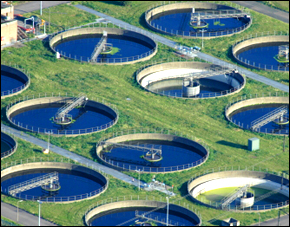Q&A: How General Electric is Tackling the Water Crisis
Circle of Blue interviews General Electric Water’s Director of marketing Jeff Fulgham.
By Andrew Maddocks
Circle of Blue
Director of marketing for General Electric Water Jeff Fulgham is at the forefront of the multi-billion dollar company’s conservation plans. Fulgham has to understand the water-energy nexus, as well as the ongoing water rights battles in order to push GE forward. From implementing environment- and bottom line-friendly policies for GE and its clients, to tackling local water shortages across continents, Fulgham reveals how the corporate sector is reshaping its relationship with one of the world’s most precious resources.
From the 50,000-foot perspective, how far have we come in the past four or five years in the corporate water sector?
At a macro level, it’s the same basic factors we were looking at four to five years ago, but just on steroids.
In particular, this imbalance of supply and demand is the macro driver. Globally we’ve reached a tipping point, depending on whose data you look at — global demand now is exceeding supply. In some parts of the world it’s much greater than others.
What we see is that imbalance is being made up by water reuse, desalination continues growth but at a slower pace than what we saw five years ago, and we’re drawing down our reserves. When you look at major reservoirs, whether it’s Lake Mead or its peers around the world, we’re tapping into reserves, underground aquifers and other places to make up that deficit.
We’re seeing that becoming more of an issue. So we’re working two drivers — one is trying to reduce that demand, and then create new supplies through things like desalination, water re-use and other technologies.
The second piece we see is water quality, which is hitting our customers in two places. They’re having lower quality water coming to their asset — industrial plant, municipality, whatever — and they’re also having to meet more stringent regulations on the discharge side in some places in the world. They’re pinched in the middle, at least in the developed world.
We still see some challenges in Eastern Europe and other places where policy isn’t keeping up, so water quality continues to deteriorate.
The third big thing that’s really starting to get attention, that didn’t have nearly as much five years ago, is water pricing.
That’s really a driver for the first two megatrends. Water price still is not equivalent to [the resource’s] value in most places. It makes it tough to justify some of the investment to improve our situation.
It’s one of the challenges we run into with beneficial water reuse and really approaching a lot of the development in a smarter way. Customers aren’t feeling a cost for their water so they’re reluctant to spend money to improve their situation.
Tucked into those three big trends are the regulatory components around water quality, water rights issues, and policy in general from an incentive standpoint and penal standpoint.
It’s only recently that these pieces have even been looked at in the same universe.
Yes, that’s exactly right. In many parts of the world unfortunately they’re still not. As we work with India, we see this total disconnect between the need for power generation growth — 60,000 megawatts of power needed — and for wastewater treatment.
We’re trying to bring some of those bodies together to talk about co-solution here. If you would co-locate a wastewater treatment and rescue plant and use that as source water for your power plant, all of a sudden it’s a new game. But it’s really hard to bring the right people together in some parts of the world.
Is co-solution a piece of the major trends that could emerge from the road map you’ve given us in the corporate sector?
The energy and water nexus piece, to us, comes in three or four different areas; one is power generation itself.
Power continues to be a big hog of water. Depending where you are in the world more than 50 percent of water consumption is going to power generation. So project out 10 to 20 years and the ways we’re going to meet the new power generation needs are potentially more water intensive than in the past. In the past there was a lot of once-through cooling in power. While it touched a lot of water, it wasn’t that much consumption, and the water was relatively unchanged from front to back.
Now we see a lot more consumptive water use. As you look at power generation of the future it’s a different mix, and that mix has a different demand on water. That’s one piece of the whole power energy nexus.
The other piece is to generate fuels we need in the future to meet the broader energy demand. Fuels production is incredibly thirsty.
The other piece connected to that is the unconventional gas base. As we see the growth of shale in various gas regions in the U.S., or in Australia, these new sources are very water intensive, in production and recovery and wastewater. You could also push that one step further to coal mining.
Could you talk more about India’s disconnect between power generation and wastewater treatment?
If you think of it as a country you’re missing something; each of the states is so very different. Just from climate to environment you can go from desert to monsoon and everywhere in between. You’ve got this very dynamic country with very dynamic states with incredibly different philosophies on government, policy everything else.
You have very high numbers of people with essentially untreated wastewater. You’ve got an incredible demand, with food and population growth and everything else. And you have an even greater pinch on the water supplies.
You’ve got all these weird dynamics going on at the same time you have a growing middle and upper class that are demanding water. You’ve got all these demand-side pieces for both water and energy. We’re struggling because there are very independent groups at the federal and state level that address both water and power. It makes it hard to look at kind of a joint solution.
I think they’re underestimating the impact of the need for water on this power growth. There’s a heck of a need for interplay between seeing this as an opportunity, solving this waste problem and at the same time giving yourself a nice sustainable water supply for the power industry.
If you were to walk into World Economic Forum or Chamber of Commerce and draw a road map for five years, what are a couple of the untold stories that maybe are emerging on the radar?
Agriculture is a real challenge. I think of basic things like, why are we subsidizing the price of water for farmers, which removes any desire to reduce consumption, while at the same time not subsidizing low flow or alternate irrigation methods?
There’s enough data and technology out there proving we could reduce our water needs for irrigation by 50 to 70 percent globally, with technology that’s affordable today. But there’s no incentive as long as we’re subsidizing the price of water, not technology.
So, if I were king, I would first address this wacky imbalance of water use for agriculture, for irrigation. As we grow from 6.3 billion to 9 billion people in the next 30-plus years it’s only going to get worse.
We can attack water consumption in the industrial sector. But even if we cut that in half we only make a dent in the imbalance because of the agricultural demand. I think we have to deploy companies like Toro and John Deere with great low-flow irrigation technologies first.
It’s also a big vicious circle. As we over irrigate, we wash all the phosphorus-based materials into the lakes and streams. This run-off concern causes water quality challenges, so you end up with this loop that you just can’t fix
I think we can really get ahead of that.
I do think there’s greater opportunities in incentives than penalizing. We’re working now with the U.S. government for a 30 percent tax credit for instance, for beneficial reuse in an industrial sector, with the right energy footprint. You can’t do a total tradeoff with high-energy consumption in order to produce that water.
There’s this opportunity to incentivize the right behavior rather than smack people when they don’t behave. We’re big fans of incentive versus mandates, and that type of regulatory policy.
So we think investment tax credits that worked in wind could work in water reuse. There are other ways to incentivize municipalities to do the right thing. It doesn’t take a lot of investment to go from a municipal wastewater plant that’s treating to discharge and clean up tertiary treatment, and purify for beneficial reuse for power or whatever industry.
We’d love to see a lot more of that going on rather than dumping back to sea.
How are you seeing GE taking on internal water use, and internalizing your own processes and thinking? What are you learning, and what can other companies learn from you?
We’ve really aggressively gone after water consumption in our own sites. In May 2008 we committed to reduce our own consumption 20 percent by 2012. We’ve upped that to 25 percent reduction by 2015.
We’re already well down that path. We’ve got about 7,000 rooftops or so around the world, and so we’ve been working on a step-by-step process across all of our business units looking at the big water consumers. We work very closely with our corporate environmental team, and look at the top 100 water users.
Then we do treasure hunt events where we take groups into major water-consuming sites and do a full river-to-river assessment.
We look at at all the ways we could reduce consumption from the inlet to the outlet, and look. A lot of this is improving operating procedure, not spending a bunch of money to install a lot of equipment. It’s smarter operating.
We’re also installing water re-use systems, waste water treatment, cooling towers where once-through might have been used, replacing old lime softening with reverse osmosis, much more water-smart systems.
We’re going plant by plant through this step-by-step process to reduce our own consumption, and we’re having a lot of success.
What motivated GE to cut its own water use?
It started as the right thing to do to help solve the world’s biggest environmental challenges and drive profitable growth for GE. It was a goal that we set just like greenhouse gas reduction and other things. What it’s become is the individual plants look at investment and water improvement to have a return on investment that justifies the capital invested.
It’s brought a lot of real savings which drop right to the bottom line that they weren’t necessarily looking at.
It gets back to water cost again. One of the big industrial GE plants thought of their water as essentially free. They were drawing it out of a river, and didn’t think about paying for the discharge either. In reality, with account pumping costs and labor and everything else, there was a tremendous cost to their water that they weren’t really seeing. It wasn’t like a water bill that we would see on our home expenses.
So when you bring all that to light, it was a fantastic return on investment.
You appear to be in a unique position that can extend lessons and methodologies you develop internally to your clients.
It’s a lot of work to do that, but people are willing and able. It’s definitely beneficial. In some cases GE is almost a tougher customer than most of our customers. We’re a very demanding company.
We have to have that solid return that meets GE’s own financial goals. It’s a great process. We’ve learned a ton working with our own GE plants that we can take to our customers.
Are you looking at any additional conservation targets beyond 2015?
We’re going to walk before we run, but we feel like we can do significantly better. It’s kind of low-hanging fruit, and as we look at the next 100 plants, it gets harder and harder.
A lot of our assets are commercial buildings. There’s not a lot you can do beyond low-flow toilets and that kind of thing. It ends up being very marginal return on the investment. What we’re looking at is the large consumers, the big industrial plants.
There are literally billions of gallons of water we can reduce, so that’s what we’re going after.
How do the human rights dimensions of water factor into your work within GE or with clients?
It’s a huge deal for us, one that we challenge ourselves with and that we are challenged with.
We do quite a bit with GE Foundation. Typically the Foundation gives somewhere around $100 million through health care and various other parts of our business. We’re a big part of that. We’re giving pure water systems to hospitals in Ghana. So around the world we do philanthropic things.
But those aren’t long-term sustainable, repeatable things. Those are individual efforts we make to improve lives. What we’re trying to do is make a more widespread impact, at that bottom of the pyramid.
We have a small, internal board within our water business. We have our monthly reviews, and constantly look for opportunities to work with governments and customers around the world.
There’s three legs to that stool: One, you have to have technology that honestly is hard for GE at times. We’re always trying to take the next frontier of the coolest new technology. In most cases that’s not what’s needed at the bottom of the pyramid. You need simple to maintain, inexpensive technology.
Sometimes it’s tough for us because we innovate way at the front end, and we have to think a little bit differently. There’s a technology component to it.
The second leg of the stool is around funding. There’s a lot of funding. We work with a number of big foundations like the Gates Foundation and Tata Foundation in India that are interested in helping this problem, but want to partner up with someone like GE.
The third thing we look for is a local entrepreneur on the ground, somebody that has a vested interest and can really make this work.
There’s 600,000-plus villages in India and 200,000 of those have water quality below human health standards. It’s tough to go solve challenges of 200,000 villages. So we’re trying to build repeatable, sustainable programs that might be funded by a third party and implement our technologies.
But we might also enable a local entrepreneur to install a water kiosk and sell water for a few rupees a day to citizens of that village and make it sustainable, and so you can create a small-business model there.
We’re looking at water kiosks in China, we’ve got about 1,000 in India, we’re looking at solar-based kiosks that are independent of the grid in Pakistan — we have a number of projects around the world that are experiments in making these local business models work.
Any other trends you’re seeing?
We’re seeing a wonderful trend at the college level. I work quite a bit at schools looking at new talent, and there’s a wave of water-based classes and MBAs with an environmental and water background. It was really neat over the last couple years to see interest level rise. People that never would have thought about water or the environment, you know, the Harvard MBA types, are all of a sudden passionate about trying to address this challenge.
That’s an area that I think is exciting, to see the twenty-somethings care very differently than I know I did when I came out of school.
Andrew Maddocks is a reporter for Circle of Blue. Reach Maddocks at circleofblue.org/contact. To read more about emerging trends in the world of water click here.
is a Washington, D.C–based correspondent for Circle of Blue. He graduated from DePauw University as a Media Fellow with a B.A. in Conflict Studies. He co-writes The Stream, a daily summary of global water news.










Isn’t it a little blatant to have the Director of Marketing leading a greenwashing effort?